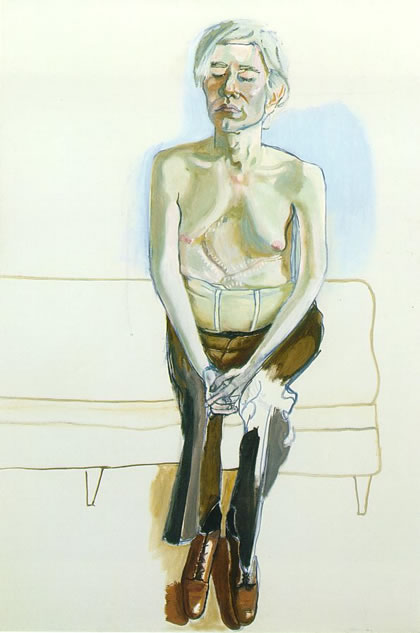As my project progressed, an important concern that arose was the question of the place of photography in my working process. It is nowadays common practice among artists and painting students to use photographs as reference material in the construction of their artwork. However, to paint from life and to paint from a photograph are not the same thing: indeed, they generally result in images of a different quality
(11).
In a video biography of the American portraitist Alice Neel, Robert Storr (the dean of Yale University School of Art) discussed the difference between painting and photography. While the photograph captures a single moment frozen in time, a painting takes place over a longer period, recording through the layers of paint the time taken in the sittings. A painting is an ‘extended moment’, not just ‘time stopped.’ And, ‘...the mere fact that painting is not a second arrested but is a relationship of seeing and of the see-er and the subject means that painting contains duration, somehow.’
(12) In portrait painting when the image is made from life, a relationship builds between the artist and the sitter. Conversation happens, and the person is presented in the painting as the artist saw them over that period of time. The portrait in this context is a record of their interaction. In the case of Alice Neel, she wanted to paint ‘real people’
(13), and her portraits presented a psychological exploration of her subjects. A direct contrast to this is the common contemporary practice of constructing painted portraits primarily from photographic sources. While this often leads to a more exact representation of likeness and is more convenient for both parties, the relational interaction between artist and subject is significantly reduced. In the 2004 portrait of David Gulpilil by Craig Ruddy, which won the Archibald prize, Ross Woodrow
(14) claimed that Ruddy had created a caricature based on a stereotype. The reasoning was that Ruddy had formed his idea before he even met Gulpilil, and their only contact was a few hours from which Ruddy could start the portrait. The portrait in this sense did not come from any artistic insights into Gulpilil’s character but rather the projection of the artist’s assumptions onto the subject’s face. It displayed a distinct lack of personal relationship between them.
(Alice Neel, Andy Warhol, 1970, Oil on canvas, 152.4 x 101.6 cm)
(Craig Ruddy, David Gulpilil, Two Worlds, Charcoal and mixed media on linen, 2004)
Like Alice Neel,
Lucean Freud also painted from life, constructing his
nude portraits over many sittings, sometimes in the hundreds. With the shifting of the artist and subject during these interactions, it is evident that, "these works are painted over time, and consequently time itself is captured in the accumulations of paint, in the shifts in perspective, in the physicality of the subject."
(15) In her book,
Painting People, Mullins presents the work of a number of artists who choose to paint the human figure in an age dominated by visual technological reproduction. With regards to painting and photography, she discusses most painters seeing their works as an ‘antidote’ to the constant barrage of images that are shot at the viewer daily in our world: "Paintings create pauses in life, and offer distillations of subjects rather than unconnected snapshots."
(16)







